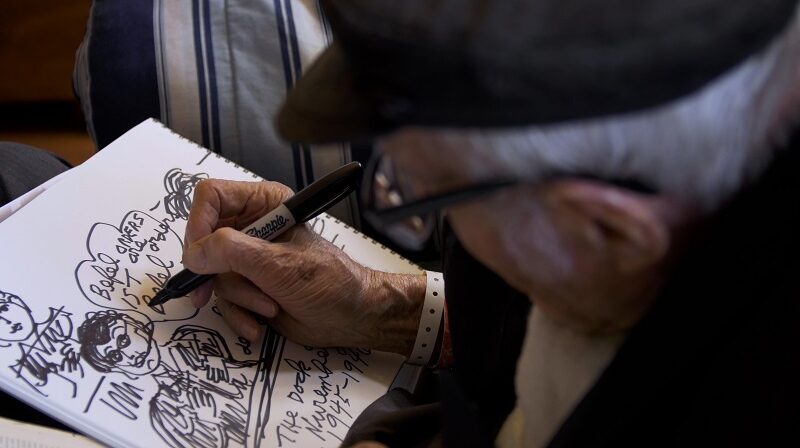Nathan-ism (Golod, 2023)
Nathan-ism is a near-miss of a documentary that has a promising subject and appears to stumble across an important and unexpected angle, but it is ultimately unable to put the pieces together in a way that would tell the story effectively.
The subject is Nathan Hilu, a nonagenarian Jew who claims to have acted as Hermann Göring’s guard during the Nuremberg Trials. Hilu makes a unique style of art, combining drawing and text to process his traumatic memories of World War II. The first part of the documentary focuses on broad themes, including what makes his art different and attempts to enhance his reputation in the art world.
But then the documentary abruptly shifts gear as some of the interviewees begin discussing not Hilu’s art, but the uncertainty of human memory. The film begins discussing what it would mean if Hilu had manufactured his memories…before it even explains what led to anyone questioning them in the first place.
Much of the back section of the film revolves around attempts to verify parts of Hilu’s biography, which proves to be a difficult task because an archive of military records in St. Louis caught fire. This part of the story is told clearly enough, but I was still confused as to what led the film producers to search the military records or doubt his recollections in the first place.
It is actually pretty rare, when a movie falters, that I can clearly extract and label one element as the cause. Film is a collaborative medium, and it can be hard to assess whether problems are the result of writing or acting, directing or cinematography. In this case, however, it was the editing that left me frustrated.
Late in the section about attempts to verify Hilu’s account, the filmmakers introduce the most damning piece of evidence — an old interview in a Jewish periodical in which Hilu appears to claim (in contradiction to his contemporary claims that he saw Göring’s wife visit him and kiss him immediately before his execution) that he left the trial weeks before its conclusion. Then there is a passage where the filmmakers question Hilu and he shows the antagonistic reactions that a previous interviewee had described as the cause of her distrust….but which we hadn’t yet seen on camera.
So what is going on here? Were there elements that made the filmmakers suspicious earlier that were bracketed out of the first half in order to influence our judgment? Was Hilu’s affect (as it appears) a response to distrust rather than the cause of it? Once the film finally gets out into the open the causes of the question, it almost immediately answers them by having the researcher uncover a key piece of evidence. Thus there is never any time for us to formulate an opinion or to feel tension or understand the stakes. It’s as though we are told what the stakes of the question are, given the answer, and only then told why it was asked. This very strange editing robs the documentary of much of its potential impact because there is only a very short stretch during which the validity of Hilu’s memories is questioned and that is through second-hand explanations of people who questioned it rather than through presenting the evidence to the viewer and inviting us to question.
Perhaps the filmmakers didn’t want to dwell too much on the doubts given the resolution, but then why introduce them at all? At 79 minutes, the film isn’t particularly packed. Was there not enough of a story to reach feature-documentary length? Or was this intended to be the core of the story and it just wasn’t executed well? Either way, we are left with a fascinating topic and only a very superficial examination of its importance and relevance.

